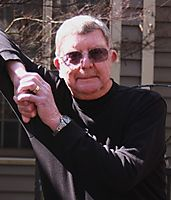Crime Scenes and Alternate Light Sources
Don Penven
See also the instructional video "Evidence Photography — Alternate Light Sources"
Alternate light sources, a much needed tool for CSIs
Over many decades, visible light sources were used during most searches of crime scenes. Although some forensic investigators would occasionally use ultraviolet (UV Black Light) to examine for crime scene evidence, white light was the mainstay. But in the 1970s the Royal Canadian Mounted Police (RCMP) added a new dimension to forensic examination of physical evidence.
The “Mounties” pioneered the use of argon-ion lasers, but these expensive, cumbersome, bulky machines were impractical for use at crime scenes, so their use was limited to the crime lab.
The birth of alternate light sources
Portable lasers began to appear in the marketplace in the 1980s, but their usefulness was limited to mostly a single color of light. In the 1990s the availability of high intensity incandescent lamps slowly revolutionized alternate light source analysis of physical evidence since these machines, many weighing less than 20 pounds, could provide an intense light beam that could be passed through various filters covering from visible blue, green, yellow and red light. Using these colors enhanced the ability to reveal an abundance of what would otherwise be invisible evidence. But one element is still missing.
What is fluorescence?
Merely shining a blue or other visible color light onto an object in and of itself does not show us much. You see, certain materials possess a property called fluorescence. Fluorescence occurs when light of a certain color and light frequency strikes an object, and the object returns light of a different color and frequency. This fluorescence is much weaker in intensity than the light beam that created it, so to visualize the fluorescence, the crime scene technician must use filtration that blocks the visible light but passes the fluorescence. For example: if the visible light beam is blue light, the filter must be orange in color. This blocks the intense blue light but passes the weak fluorescence. UV light, on the other hand, is invisible, but it produces visible fluorescence from certain objects and substances. No filtration is required to view UV fluorescence, but eye protection in the form of clear glass or plastic lenses is recommended.
Detecting hidden blood stains in crime scenes
If you watch many of the TV “Cop” shows, you will see at some point those working a crime scene using a blue light in search of invisible blood (blood stains that were cleaned up). Shazam! Blue-white stains appear all over the floors, walls and objects sitting around the crime scene! But in reality—this cannot happen. You see, blood does not fluoresce by applying UV or visible blue light.
Blood, even minute quantities that remain after clean-up, can be made to “luminesce;” that is, by spraying certain chemicals such as Luminol, BlueStar or Fluorescene on the various surfaces, blood will luminesce, or simply “glow in the dark”—and adding blue light is not necessary. So what can alternate light sources reveal? Although blood does not fluoresce, certain other physiological fluids will. UV alternate light sources can reveal the following: seminal fluid, saliva and urine stains. Also, certain narcotics will fluoresce as will bone and teeth fragments.
Other uses of alternate light sources Indeed, many forms of physical evidence will fluoresce. But modern science has resulted in the development of chemicals that “make” objects fluoresce. When using fluorescent chemicals, latent fingerprint development can be greatly improved. Fluorescent latent print powders have the ability to make the latent residue on a surface fluoresce. The benefit here is that the ridges fluoresce brightly and when photographed, a multi-colored or confused background can be minimized to the point where it does not show up in photographs. Fluorescent liquids are used to develop latent prints on porous surfaces such as paper and cardboard.
Fluorescent dyes are used to enhance latent prints developed using superglue fuming. The use of alternate light sources provides a highly practical and efficient means of locating physical evidence at crime scenes. The invention and perfection of Light Emitting Diodes (LEDs) has further advanced evidence recovery since even 1 and 3 watt LEDs can be installed in small, hand-held flashlights, and their performance is remarkable.

About the Author
Don Penven has more than 35 years direct and indirect experience in law enforcement. He currently serves as a technical support representative and technical writer for Sirchie Finger Print Labs.
Article submitted by the Author
Article posted: April 4, 2013

